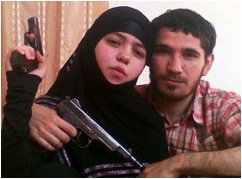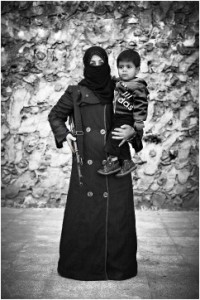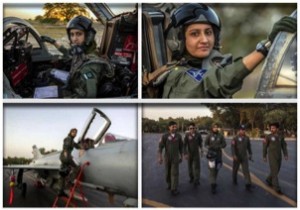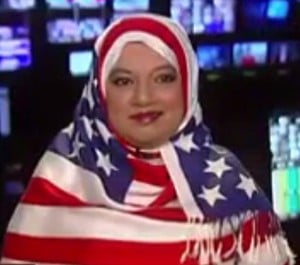In the past few years, images of Muslim women in war settings have become increasingly common, from depictions of Syrian female rebels to all-American girls being compared to Chechnya’s so-called “Black Widows.”
Last year, while writing an article on the “Black Widows” I started reading reports about Muslim women’s participation in armed struggles and noticed that female violence is often attributed to the loss of male family members, emotional distress (which often goes unreported for their male counterparts) or brainwashing by male Islamists, especially when it comes to Muslim female converts or young Muslim brides.

Muslim women involved in conflict are often categorized as desperate mothers, brainwashed victims or as tomboys. Mainstream media sources usually refer to these women’s families, irrational emotions and love stories.
Back in April, for instance, Feature Shoot and Time World showcased “portraits” in black and white of an all-female Free Syrian Army unit that portrayed women posing with their weapons and babies (I am still waiting for the pictures of male rebels carrying their offspring). Similarly, “Guevara” a female Syrian rebel fighter has been despicted as a cold-blooded woman seeking revenge for the death of her children, rather than being seen as politically-motivated, like her male counterparts, who have probably also experienced personal loss.
Motherhood and marriage seem to legitimize Muslim women’s presence in armed conflicts, and allows mainstream Western media outlets to “make-sense” of shocking images of Muslim women carrying weapons and babies. It seems much of the mainstream media prefers mothers in black caring for wounded men, like Samuel Aranda’s award winning picture, which I discussed last year. Femininity does not belong in the struggle and when women are involved in conflict it has to be explained away through tying women back to the domestic sphere.
If the motherhood card cannot be played, we are faced with a problem… why are Muslim women fighting? And why are Western Muslim

converts getting involved in Middle Eastern/African conflicts that are not their own? The answer is simple… they must be manipulated by men. Not only did media reports point at Katherine Russell, widow of Tamerlan Tsarnaev, as being brainwashed but recent reports of the death of Nicole Mansfield, a Muslim convert, refer to a “misguided” link to Syrian rebels. Curiously, the process of brainwashing seems to require male influence, particularly that of a husband, boyfriend or lover, as if convert Muslim women married only strangers with secret agendas for their new-to-Islam wives.
There are some stories that do not link the women to their children or husbands, but these often fall back on the women’s appearance. In an article by ynetnews, for example, on Ayesha Farooq, Pakistan’s first female fighter pilot, we are told that her “slim frame offers a study in contrast with her burly male colleagues”. In an article by Time World, Em Joseph, a female Syrian rebel, we are told she “doesn’t really look like many of the women in this socially conservative stretch ofSyria‘s Idlib province, and she certainly doesn’t act like them.”
Although Em Joseph is called a “lady” in the same article, the author goes on:
“Perhaps her only concession to femininity is the pattern of maroon and creme swirls on her loose, floor-length beige robe, but if it weren’t for the swirls, the garment could easily be a man’s galabiya. And then, there’s her Kalashnikov rifle.”

Both women’s femininities are reduced to the authors’ perceptions of their looks, their clothes and their weapons, while highlighting how unique they are given their “socially conservative” milieu. Em Joseph, for example, is described in the article as “a rarity.”
Muslim women have to fit cookie-cutter notions of motherhood, victimization and femininity, or be deemed aberrations while their agency continues to be denied. Their decisions to engage in armed conflicts cannot be explained away by placing them into the arbitrary categories of vengeful mothers, brainwashed wives or trigger-happy tomboys.
Has anyone considered that perhaps Muslim women as individuals have their own reasons for participating in armed struggles? Describing these women’s physical appearance or marital status does not help us understand why any of them, as individuals, rather than as a representative of “Muslim women” decided to grab a gun or to become a fighter pilot.











